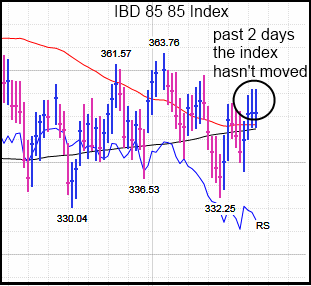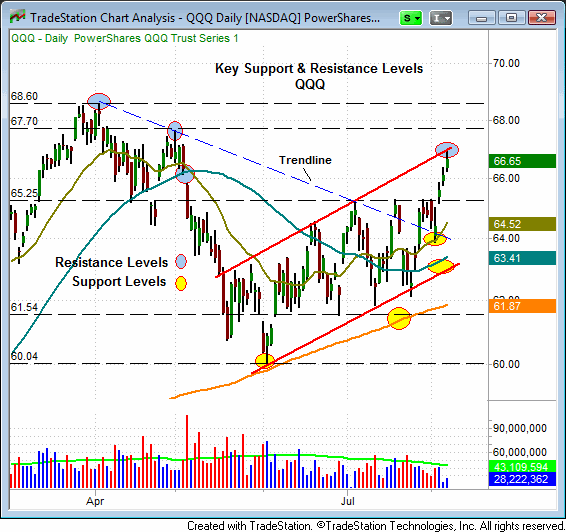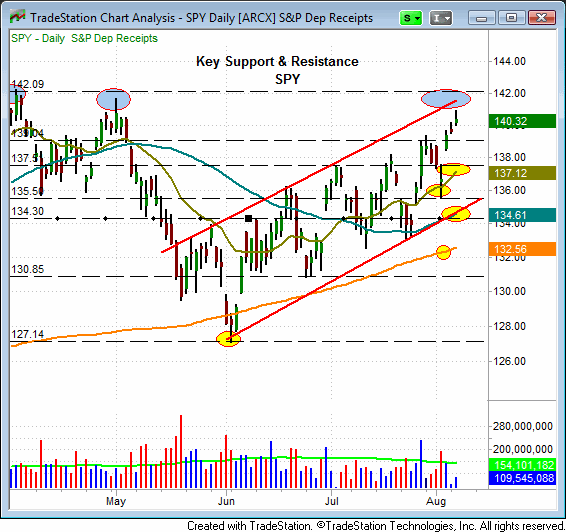Over the past week, sentiment in the U.S. stock market seems to have improved. The main stock market indexes have rallied to break out above technical resistance of their July “swing highs” as stocks have cruised steadily higher. Certainly, this is encouraging, and is a welcome change from the choppy, indecisive price action of July. However, a closer look at what’s been moving the stock market higher causes us to believe there are some key problems with the current stock market rally.
Overall, the main issue confronting stocks right now is that the recent rally has not been led by small and mid-cap growth stocks, as is typically the case in healthy markets. This is best summarized with the graph below, which is a snapshot of the IBD (Investors Business Daily) “85/85 Index.” This index is comprised of stocks that rank in the top 15% of all stocks, both technically and fundamentally. This is a growth index, primarily comprised of small and mid-cap stocks. While the S&P 500 has pushed higher the past few days, notice the 85/85 Index has gone nowhere:

source: DailyGraphs.com
As the graph above indicates, leading small and mid-cap growth stocks have pretty much remained stagnant, despite the rally in the broad market of the past few days. This means the rally has been primarily led by established, large-gap stocks. But, there’s even a problem with those large-cap stocks that have been rallying as well…they are mostly dogs.
Last night, we ran a proprietary stock scan that compared yesterday’s (August 7) closing prices of stocks that comprise large-cap Russell 1000 Index versus their closing prices of three days prior. Out of the top 50 individual largest percentage gaining stocks during this period, we found that 43 of those 50 stocks (86%) started their rallies from below major tehnical resistance of their 200-day moving averages. Put simply, this means that most of the stocks that have been rallying in recent days have been “junk off the bottom” plays. Since our stock trading strategy focuses on buying breakouts and pullbacks of strong, uptrending, there remains a lack of quality, momentum-driven ETFs and stocks to buy for short-term trading. Further, the fact that small and mid-cap stocks continue to lag remains a concern.
Additionally, it is important to note that several of the broad-based indexes are at or nearing key resistance levels on their daily charts. Yesterday, for example, the PowerShares Nasdaq 100 ETF ($QQQ), a popular ETF proxy for the Nasdaq 100 Index, rallied into resistance of the upper trend line of its ascending trend channel, then sold off to close in the middle of its intraday range. As such, yesterday’s high should now serve as a significant near-term resistance level for QQQ, which could lead to at least several days of sideways consolidation or price retracement. If QQQ moves above this key resistance level, there is still additional horizontal price resistance at $67.70 and $68.60 (the dashed black lines on the chart below). Should QQQ pull back from its current level, it should find near-term support near $65.25 (the recent breakout level), $64.50 (20-day EMA), and $63.40 (50-day MA):

Like $QQQ, the S&P 500 SPDR ($SPY), an ETF that represents the benchmark S&P 500 Index, has also found resistance near the upper trend line of its trend channel. However, $SPY found resistance just below this key mark. Above yesterday’s high, $SPY may find major price resistance from the $141.50 to $142.10 area (upper channel of its trendline and horizontal price resistance, respectively). On a pullback, SPY has support at its 20-day EMA ($137.12), its previous “swing low” of $135.50 and convergence of its lower trendline, and at its 50-day MA ($134.30):

Based on the two chart patterns above, it’s apparent the broad market may be approaching a “moment of truth.” The reaction to the major indices as they test these resistance levels may set the tone for the stock market’s trend for the rest of the year. As short-term swing traders, we assess price action one day at a time, and are not interested in making predictions. Nevertheless, a lot could change for the better with just a few days of convincing, bullish price action. In particular, substantial, higher volume gains among leading small and mid-cap growth stocks would be especially positive. But until happens, our intermediate-term market timing model remains neutral.
This afternoon, in a live event exclusively for subscribers of The Wagner Daily, we discussed the commentary above in more detail. We also discussed how to quickly and easily find the strongest stocks with the new MTG Stock Screener. We have made a video recording of this live event available on our YouTube channel, and you can view the video below (view full screen in HD mode for best quality). Before you start aggressively buying stocks right now, you may want to invest the time watching this video. Enjoy!
To receive daily technical analysis such as the above, including detailed entry and exit prices of our best ETF and stock picks, sign up to receive The Wagner Daily newsletter by clicking here. Subscription available at less than $2 per day (based on annual subscription pricing), and we offer a risk-free 30-day test drive.
